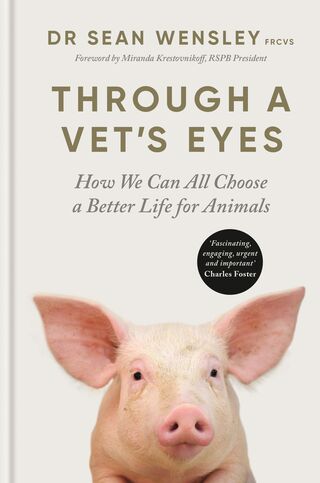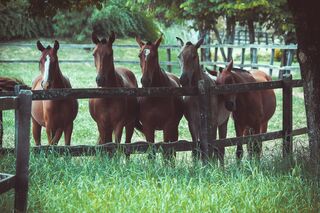Friends
The Worlds of Animals Through the Eyes and Heart of a Vet
Sean Wensley tells us how to compassionately connect with all animals.
Posted August 19, 2022 Reviewed by Devon Frye
Key points
- Sean Wensley explains how to compassionately connect with all animals so that pet rabbits have companionship and horses have their 3Fs met.
- Veterinarians play a major role in advocating for animal welfare science and humane education.
- Veterinarians can help promote nonhuman and human well-being because they are closely related to one another.
Veterinarians are incredibly important "middle people" between people who live with or use a wide variety of nonhuman animals (animals) and the animals themselves.1 In his new book Through A Vet’s Eyes: How We Can All Choose a Better Life for Animals, Sean Wensley, an award-winning veterinarian who drove the development of BVA’s first Animal Welfare Strategy, explains how we must treat all animals with respect and compassion, and the role of veterinarians in using animal welfare science and ethics to do this. I'm pleased Sean could answer a few questions about his landmark book.
Marc Bekoff: Why did you write Through A Vet’s Eyes?
Sean Wensley: I wanted to relay a number of today’s persisting animal welfare problems to a non-specialist audience through the lens of my own personal experience, to help make those problems more accessible and understandable.
I then wanted to underpin these experiences with animal welfare science (the science of understanding how animals perceive the world, and what they need and want from their perspectives) and veterinary animal welfare policy, and embed the veterinary memoir elements in the context of the natural world. This helped me discuss animal welfare alongside other pressing issues, such as climate change, biodiversity loss, and antimicrobial resistance, and to promote the importance of interdisciplinary working as embodied by the One Health and One Welfare approaches.
Importantly, I wanted the book to be solutions-focused and hopeful, rather than simply outlining problems. While there are many problems still to be addressed, there is also progress that we can point to and take inspiration from.

MB: How does your book relate to your background and general areas of interest?
SW: As a veterinarian—first practising and later developing veterinary animal welfare policy with species-specialist colleagues—and during my years as a veterinary student, I have been privileged to have had first-hand exposure to many of the ways in which animals are used by humans today. In doing so, I have become aware of how billions of animals are not having their welfare needs met.
It’s my professional responsibility to advocate for these animals’ best interests, both within the bounds of the status quo (how we currently use animals) and to challenge the status quo (asking, how should we use animals?)
I consider myself fortunate to have grown up near the coast, exploring the wildlife in the sand dunes and pinewoods in the northwest of England. Several parts of the book are set in that part of the world, relaying times spent observing, for example, rare red squirrels, natterjack toads, orchids, and migratory geese at their thousands-strong dawn roost. The resultant nature writing sections provide some levity and space for reflection in the book, and they also remind readers of the evolutionary origins of our domestic animals and how this relates to considerations of their wellbeing.
MB: Who is your intended audience?
SW: The book is written for non-specialists, but also has broad appeal for veterinary professionals, animal welfare scientists, other researchers, students, and anyone with an interest in animal welfare and sustainability more broadly. One reviewer kindly described it as: ‘informative and convincing, challenging yet measured and hopeful, personal and universal, interesting, engaging, scientifically rigorous and poetic!’
MB: What are some of the topics you weave into your book and what are some of your major messages?
SW: The book is about our relationships with animals, how they feel from the animals' perspectives (assessed using animal welfare science) and how we can improve them (through individual actions and how these actions can contribute to broader societal transformation). It includes chapters on farmed animals, companion animals, animals used for sport, and wild animals impacted by human activity.
Some of the broad themes include the importance of taking the perspectives of the animals we keep and use for our benefit as a starting point for considering their welfare and recognising their morally relevant commonality with humans, but not mistakenly assuming they are "just like us," which risks our not providing for their species-specific needs.

For those with an interest in the veterinary profession’s role in animal welfare, the book draws on various veterinary animal welfare policies and recommendations, such as: advocating an end to the use of farrowing crates; pet rabbits to have appropriate companionship; horses to have their 3Fs met (Friendship, Freedom and Forage); improvements to welfare at slaughter; and the end of routine mutilations in animal agriculture.
MB: How does your book differ from others that are concerned with some of the same general topics?
SW: One reviewer, in comparing the book to Peter Singer’s Animal Liberation, titles in the UFAW Animal Welfare series, and Philip Lymbery’s Farmageddon—which the reviewer selected for representing a philosophical treatise, scientific accounts, and a campaigning text, respectively—said that Through A Vet’s Eyes "strikes a clever balance between these often competing positions."
MB: Are you hopeful that as people learn more about what being a veterinarian actually entails they will have a greater appreciation for what you all do—the ups and downs and the challenges?
SW: I hope that the book will help raise awareness of the ethical dimensions of veterinary work, which have risen to prominence in recent years and are an increasingly important aspect of veterinary training, research, and practice. A key element is that promoting the best interests of animals under our care is necessary but not sufficient in fulfilling our duty to animal welfare; the veterinary profession must concurrently speak up about the root causes of animal welfare problems, raising public awareness and challenging the status quo of animal use.
We have a duty, as trusted professionals, to provide animal welfare leadership, and for our advocacy to promote positive animal feelings as well as to prevent negative ones.
References
In conversation with Sean Wensley, an award-winning UK veterinarian and recent President of the British Veterinary Association (BVA). He chairs the Animal Welfare Working Group of the Federation of Veterinarians of Europe (FVE), which represents veterinary organisations from 40 European countries. Sean has contributed to animal welfare and conservation projects around the world and in 2017 received the inaugural World Veterinary Association (WVA) Global Animal Welfare Award for Europe. He is a Fellow of the Royal College of Veterinary Surgeons and a Senior Veterinary Surgeon at the national UK veterinary charity, the People’s Dispensary for Sick Animals (PDSA). His media appearances include BBC Radio 4 Today, BBC Breakfast, Good Morning Britain and The Big Questions. Sean’s first book Through A Vet’s Eyes: How We Can All Choose a Better Life for Animals was one of the Financial Times’ Best Summer Books of 2022.
Veterinarians Can Help Promote Animal and Human Well-being.
Veterinarians Must Know What Dogs Are Thinking and Feeling.
Veterinary Ethics: Dogs Must Get the Very Best Care Possible.
A Veterinarian's Stories of Love, Loss, and Hope.
Veterinary Ethics: Life & Death Decisions in the Real World.




